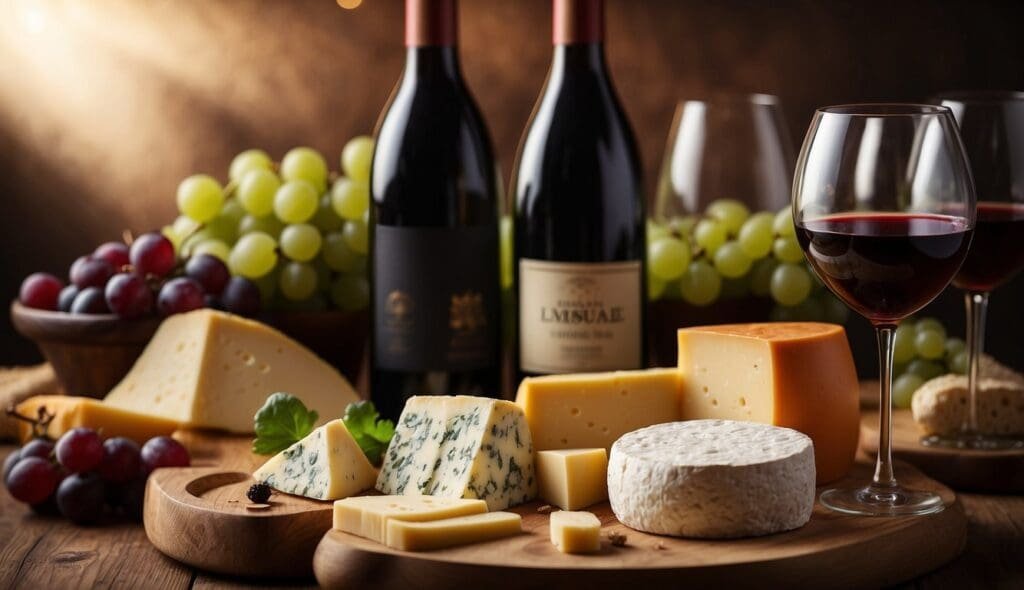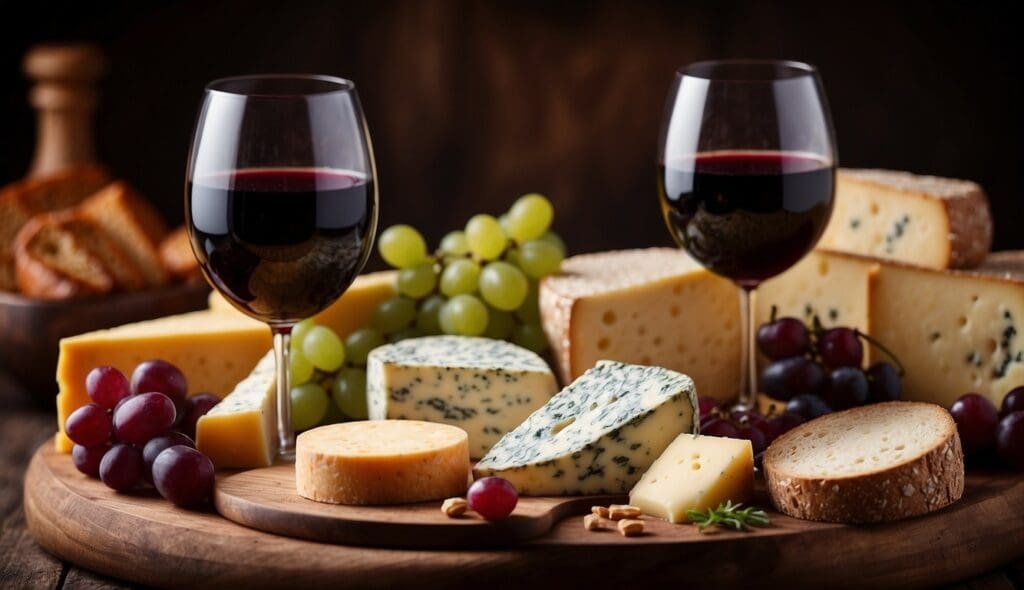This post may contain affiliate links. Please read my disclosure policy.
Ever wondered what the best red wine with cheese is for your next gathering? Finding the perfect pairing can elevate your tasting experience to new heights. A perfect example is pairing Merlot with cheese; the deep cherry and plum notes of this wine complement both sheep’s milk cheese and cow’s milk cheese beautifully.
But that’s not all. Shiraz, known for its bold flavours of blackberry and pepper, pairs excellently with a rich blue cheese like Gorgonzola. The sharpness of the cheese is balanced by the wine’s fruitiness and spiciness, making it a must-try combination.
For a more delicate option, try pairing Pinot Noir with Brie or Camembert. The soft texture and mild flavour of these cheeses work harmoniously with the light, fruity notes of a well-aged Pinot Noir. This pairing is sure to impress your guests and make your cheese platter unforgettable.
Understanding Cheese and Red Wine Pairings

Selecting the best cheese for red wine can elevate your dining experience. Here, you will learn how to match cheese and red wine perfectly by focusing on the basics and adjusting for intensity.
The Basics of Pairing
When pairing cheese with red wine, your goal is to create a balance. The flavours should complement each other without one overpowering the other.
Start by considering the tannins in red wine. Wines like Cabernet Sauvignon contain higher tannins, making them suitable for hard cheeses like aged Cheddar or Gouda. These cheeses soften the tannins, creating a smooth, enjoyable experience.
If you prefer lighter red wines such as Pinot Noir, look for softer cheeses. Brie or Camembert pair wonderfully as their creamy textures enhance the wine’s light body and fruity notes.
Experiment with Australian varietals like Barossa Valley Shiraz or Yarra Valley Pinot Noir. These wines are known for their rich flavours and can provide unique pairings with various types of cheese.
Pairing by Intensity
Matching the intensity of the wine and cheese is crucial for a harmonious pairing. Bold red wines should be paired with equally strong cheeses.
For instance, pairing the intense flavours of a Merlot with rich cheeses like Parmesan or Gruyere can be delightful. The robust wine cuts through the cheese’s richness, making each bite and sip enjoyable.
Alternatively, lighter red wines require milder cheeses. Consider pairing a Hunter Valley Merlot with softer, lighter cheeses such as Feta or Goat cheese. The gentle flavours of these cheeses won’t overpower the subtler notes of the wine.
Remember, balance is key. Understanding the intensity of both the wine and cheese will help you choose pairings that are delicious and memorable. By following these guidelines, you’ll find the best red wine with cheese combinations effortlessly.
For more detailed pairing options, you can explore resources like the best cheese for red wine or wine and cheese pairings.
Top Red Wines to Pair with Cheese

Choosing the right red wine to pair with cheese enhances both the wine and the cheese. Strong cheeses match well with bold red wines, while lighter cheeses are best with light reds.
Bold Reds for Strong Cheeses
Bold red wines like Shiraz and Cabernet Sauvignon pair beautifully with strong cheeses. Shiraz, known for its robust flavours, works well with aged cheddar or blue cheese. The wine’s tannins balance the cheese’s strong taste.
Cabernet Sauvignon, with its dark fruit notes and firm structure, complements gouda and parmesan. These hard cheeses stand up to the wine’s boldness and create a harmonious pairing.
Another excellent choice is Australian Grenache. Its fruity profile and moderate tannins make it a great match for sheep’s milk cheeses like manchego.
Light Reds for Delicate Cheeses
For delicate cheeses, opt for lighter reds like Pinot Noir or Gamay. Pinot Noir, with its elegant and subtle flavours, pairs wonderfully with brie and camembert. The wine’s acidity cuts through the cheese’s creaminess, creating a balanced taste.
Gamay, famously used in Beaujolais, pairs nicely with havarti and Swiss cheese. Its light body and fruity notes enhance the mild flavours of these cheeses without overpowering them.
Another option is Merlot. Its soft tannins and red fruit character complement the gentle flavours of mozzarella and Colby. The wine adds a touch of elegance without overshadowing the cheese.
Cheese Selection for Red Wine

Choosing the right cheese for red wine involves understanding how different textures and flavours complement various types of red wine. It’s important to consider hard cheeses, soft cheeses, and blue cheeses separately for the best pairings.
Hard Cheese Varieties
Hard cheeses are often the best choice with rich, bold red wines. Cheddar and Comté, for instance, pair wonderfully with wines like Cabernet Sauvignon and Shiraz. The intense flavours of these cheeses stand up well to the strong tannins and complex notes found in these wines.
Aged Cheddar has a nutty, sharp taste that complements the dark fruit flavours in a Cabernet Sauvignon. Similarly, Comté’s sweet and nutty profile goes well with a glass of Shiraz, known for its spicy and dark fruit notes. If you’re in Australia, seek out local cheeses like this to pair with your favourite red wine.
Soft Cheeses and Red Wine
Soft cheeses offer a creamy texture that pairs well with lighter red wines. Brie and Camembert are classic examples that can be enjoyed with Pinot Noir. The softer texture and milder flavours of these cheeses need a wine that is not too overpowering.
Brie, with its buttery and slightly fruity tang, works well with a Pinot Noir’s light body and bright fruit notes. Camembert, softer and more intense than Brie, also matches beautifully with Merlot. Merlot’s smooth, medium-bodied profile complements Camembert’s robust and earthy taste.
Local Australian varieties like Triple Cream Brie can make a delightful pairing, showcasing the region’s dairy excellence alongside its wine.
Considerations for Blue Cheeses
Blue cheeses require specific red wine pairings due to their bold and often tangy flavours. Gorgonzola and Roquefort are famous blue cheeses that need a red wine with enough sweetness to balance out their strong profiles.
Gorgonzola’s creamy and spicy flavour pairs excellently with a sweet, fruity Barbera. Barbera’s acidity and light tannins cut through the richness of the cheese beautifully. For a more intense match, Roquefort with a Port or a Shiraz can be an experience worth trying. The sweetness of Port and the boldness of Shiraz balance the sharp and salty notes in the blue cheese.
Additional Considerations
When pairing cheese with red wine, it’s crucial to taste the wine before the cheese to understand the interaction. Wines and cheeses from the same region often pair well together, offering a local experience worth exploring.
Experimenting with different pairings can open up a world of flavours, enhancing both the wine and cheese experience significantly.
Creating The Perfect Cheeseboard
Creating the ideal cheeseboard involves selecting cheeses that complement each other and pairing them with suitable accompaniments like fruits, nuts, and crackers. This approach guarantees a balanced and enjoyable experience.
Choosing the Right Cheeses
When choosing cheeses, variety is key to satisfying different tastes and textures. A good cheeseboard should include:
- Soft Cheeses: Brie or Camembert are creamy and pair well with many wines.
- Hard Cheeses: Cheddar or Gruyère offer a firm texture and robust flavour.
- Blue Cheese: Roquefort or Gorgonzola bring a pungent taste that stands out.
- Goat Cheese: Known for its tangy flavour, it pairs excellently with lighter reds like Pinot Noir.
Consider Australian varieties like Tasmanian Heritage Brie or King Island Cheddar for a local touch. Don’t forget to pair your cheese with a suitable red wine. Shiraz and Grenache are excellent with firmer cheeses, while Pinot Noir goes well with softer varieties.
Complementing with Accompaniments
Accompaniments enhance the cheeseboard by adding contrasting textures and flavours. Some good options include:
- Fruits: Grapes, figs, and apple slices offer sweetness and freshness.
- Nuts: Almonds and walnuts add a crunchy contrast.
- Crackers and Bread: Different textures from crispy crackers to soft baguette slices.
- Spreads: Honey, fig jam, and quince paste add delightful sweet notes.
When selecting fruits, consider seasonal and fresh options. For nuts and spreads, choose those with mild but distinct flavours that won’t overpower the cheeses.
Combining these elements thoughtfully ensures a balanced cheeseboard that’s both visually appealing and delicious. Pairing these with the right red wine, such as Australian Shiraz or Cabernet Sauvignon, can elevate your dining experience.
Serving and Presentation Tips
When serving red wine with cheese, several factors such as temperature, decanting, portion sizes, and placement can enhance the experience. Attention to these details ensures that both the wine and cheese flavours shine through.
Temperature and Decanting
Serve cheese at room temperature. Take it out of the fridge 30 to 60 minutes before serving. This helps the cheese reveal its full flavours and aromas.
Red wines like Shiraz and Cabernet Sauvignon from Australia benefit from decanting. Decanting allows the wine to breathe, enhancing its aroma and taste. Pour the wine into a decanter about an hour before serving. This process helps soften the tannins and brings out fruity notes which pair well with cheeses like Gorgonzola or Gruyère.
Avoid serving red wine too warm or too cold. Ideal serving temperature for red wine is between 15°C and 18°C. Use a cheese and wine pairing chart to guide your selections.
Portion Sizes and Placement
Portion sizes matter when pairing red wine with cheese. Serve modest chunks or slices, depending on the type of cheese. For soft cheeses like Brie, serve larger wedges. Hard cheeses like Parmesan can be served in smaller, bite-sized pieces.
Place cheese on a wooden board or platter. Separate strong cheeses from mild ones to prevent flavour mixing. Include complementary items like nuts, fruits, and crackers.
Arrange cheeses clockwise from mildest to strongest. This way, tasters can experience a broad range of flavours without overwhelming their palate.
Remember, a carefully balanced presentation enhances the enjoyment of both cheese and red wine.
For specific pairings, consider Australian selections like a rich Barossa Valley Shiraz with mature Cheddar or a McLaren Vale Grenache with creamy blue cheese.
Frequently Asked Questions
To master pairing red wine with cheese, it is crucial to understand how different types of wine and cheese complement each other. From bold reds to soft varieties, here’s what you need to know.
Which types of cheese pair well with a bold red wine?
Bold red wines like Shiraz and Cabernet Sauvignon pair well with strong, aged cheeses. Try stronger flavours such as Blue Cheese, Aged Gouda, and Cheddar. The intensity of these cheeses matches the richness and complexity of the wine.
What are the best red wine options to complement a cheese board?
A cheese board can offer various textures and flavours, so choose a versatile red wine. Australian Pinot Noir and Merlot are great options. They have soft tannins and enough fruitiness to pair with both mild and strong cheeses.
How should one match various cheese textures with red wines?
Match hard cheeses with tannic wines and soft cheeses with lighter reds. For example, hard Parmesan or Asiago goes well with Cabernet Sauvignon. Soft cheese like Brie or Camembert matches nicely with lighter red wines such as Pinot Noir.
Can you recommend a red wine that pairs with soft cheeses?
For soft cheeses like Brie, Camembert, or Goat Cheese, lighter red wines work best. An Australian Pinot Noir or Grenache is an excellent choice. These wines have subtle flavours that won’t overpower the delicate cheeses.
Is there an ideal red wine to serve with aged cheeses?
Aged cheeses like Parmesan, Manchego, or Aged Gouda pair well with robust red wines. Consider an Australian Shiraz or a Cabernet Sauvignon. These wines have enough body and complexity to stand up to the intense flavours of aged cheeses.
What guidelines should be followed for pairing red wines with creamy cheese varieties?
Creamy cheeses need wines that can cut through the richness. A fruity red wine like an Australian Merlot or Zinfandel is a good choice. These wines have acidity and sweetness that balance the creaminess of cheeses such as Gorgonzola or Saint-André.
User Review
( votes)Sip smarter, subscribe now!
Subscribe for gourmet tips, event updates, travel ideas, and a free e-book on Food Pairings. Start your journey to culinary and travel excellence!













